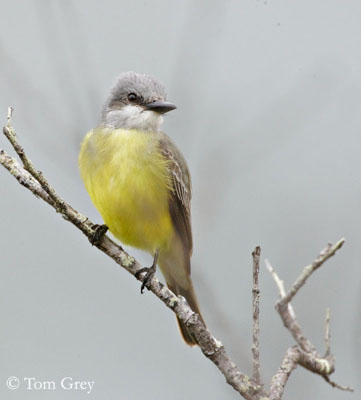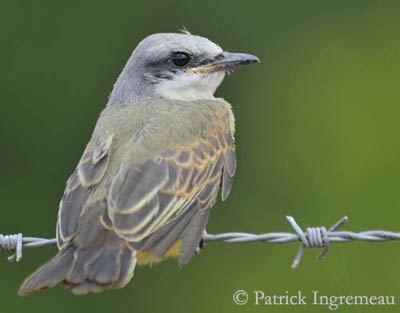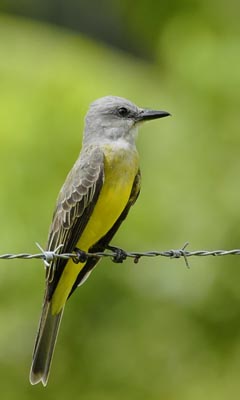
Tropical Kingbird
Tyrannus melancholicus
Passeriforme Order – Tyrannidae Family
BIOMETRICS:
Length : 18-23 cm
Wingspan : 38-41 cm
Weight : 32-43 g
DESCRIPTION:
Tropical Kingbird has pale grey head with dark grey mask. It has red-coloured patch on the top of the crown, usually concealed.
Upperparts are olive-green, with wings and tail blackish, and white edges on wing feathers. Tail is long and forked.
Throat is whitish. Breast is yellow-greenish, and rest of underparts is yellow.
Tropical Kingbird has long and strong dark grey bill. Eyes are dark. Legs and feet are blackish.
Both sexes are similar.
Fr: Tyran mélancolique
All : Trauerkönigstyrann
Esp : Tirano Melancólico
Ital : Tirano tropicale
Nd : Tropische Koningstiran
Sd : Tropish Kungstyrann
Photographs by Tom Grey
His website:
Tom Grey's Bird Pictures
Photographs by Patrick Ingremeau
His website: TAMANDUA
Text by Nicole Bouglouan
Sources:
FIELD GUIDE TO THE BIRDS OF NORTH AMERICA by National Geographic Society - National Geographic Society - ISBN: 0792274512
A GUIDE TO THE BIRDS OF MEXICO AND NORTHERN CENTRAL AMERICA by Steve N. G. Howell, Sophie Webb - Oxford University Press - ISBN: 0198540124
Wikipedia (Wikipedia, The Free Encyclopedia)
All About Birds (Cornell Lab of Ornithology)
What Bird-The ultimate Bird Guide (Mitchell Waite)
Animal Diversity Web (University of Michigan Museum of Zoology)
SORA Searchable Ornithological Research Archive (Blair O. Wolf)

VOICE: SOUNDS BY XENO-CANTO
Tropical kingbird’s call is a rapid twittering “pip-pip-pip-pip”, and also a bright “si-seep”. Song is a sweet series of “weet-weet-weet, weet, weet”, with the second part accelerating.
HABITAT:
Tropical Kingbird is found in lowlands near water, in open country with scattered trees and also in urban areas. It can be found up to 2000 metres of elevation.
RANGE:
Tropical Kingbird breeds from Southern Arizona and Northern Mexico. It winters from Mexico to South America and Caribbean, where it is resident all year round.
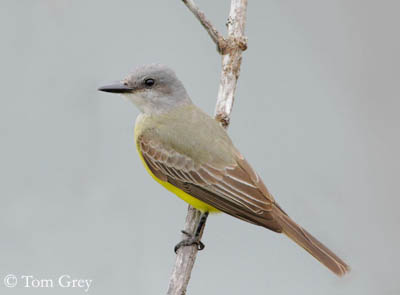
BEHAVIOUR:
Tropical Kingbird communicates through sounds. It may call with another Tropical Kingbird, or when it chases a predator. Male will call during courtship display, when it follows its mate. It also has a distinctive song, the ‘Dawn Song”, beginning before sunrise, and stopping when sun appears.
During displays, male is perched and flaps its wings, sometimes lifting off from this position.
Tropical Kingbird may perform aggressive behaviour while defending its territory, with erected crown feathers, and uttering a harsh series of twitters. It may aggressively harass a predator by dipping and dodging towards the flying intruder from behind. It may also attack perched predator individually, in pairs or in small group.
Tropical Kingbird roosts on small branches in isolated tree. They are diurnal birds, but they may hunt under artificial light at night.
Tropical Kingbird is monogamous. Pair bonds may last all year round or only for a breeding season.
Tropical Kingbird waits insects on an exposed perch and sallies out to catch one in flight. It also hovers to pick food into vegetation. It also forages on the ground.
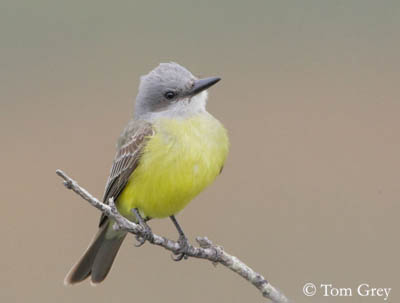
FLIGHT:
Tropical Kingbird performs a weak fluttering flight with shallow wing beats.
REPRODUCTION:
Tropical Kingbird’s nest is an open cup, situated mid-story or in the canopy. It is made with roots and twigs, weed stems and dry grasses. It is lined with hair, plant down and mosses, or unlined. It is usually located in a high fork in an isolated tree.
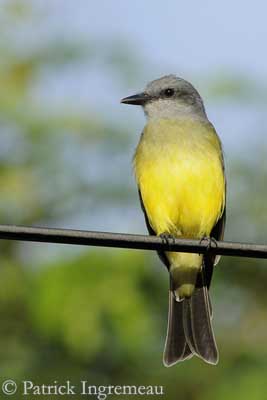
Female lays 2 to 4 eggs at intervals of 1 or 2 days. Incubation lasts about 15 to 16 days, by female only. She also broods the chicks during 10 days after hatching.
Male remains close to the nest and defends it when female is foraging for food. Both parents feed the young with insects and berries.
Young fledge at about 18 or 19 days of age. They are fed for two weeks more by both adults.
This species produces only one brood per season, and breeding season varies throughout the range.
DIET:
Tropical Kingbird feeds mainly on flying insects, but it also consume fruit and berries.
PROTECTION/ THREATS / STATUS:
Tropical Kingbird has predators such as birds of prey, and toucans. It is a host of Cowbirds which parasitize their nests.
